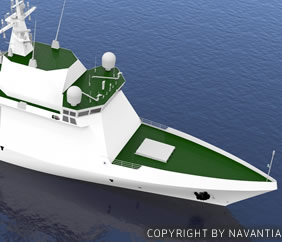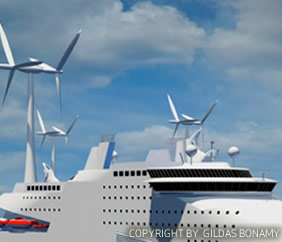OPV (Offshore Patrol Vessel)

Each country around the world operates its own fleet of Offshore Patrol Vessels (OPVs) either under the Navy flag, the Coast Guard flag or any Governmental or Public Agency flag. In the maritime market, there is growing demand for OPVs, because they are capable to perform a wide variety of missions (fishing vessels surveillance, environmental protection and duties, law enforcement and security missions and Control Including the protection of maritime traffic as well as some other applications). OPVs are usually operated near the coast, which are high sensitive areas to environmental issues. Therefore the impact on the environment assessment needs special consideration and is highly recommended for this type of vessels.
Usually OPV operating profile has a significant high percentage of low speed operation. This operating profile makes attractive the installation of propulsion systems to suit the varying loads to meet diverse operational requirements, for example, hybrid drives combining two modes of propulsion, effective both at low and full speed. For low speeds, it may be easier to implement clean technologies and therefore an open field for Research and Development is foreseen.
OPV designs are wide-ranging and perform an array of different functions, so they need to install propulsion systems to suit diverse operational requirements. Therefore, they offer a lot of possibilities to effectively integrate the management of energy systems throughout the energy chain of the vessel. Depending upon the main mission of the OPV, the different configurations usually seen in the state of the art are:
- Mainly patrol at high speed: mechanical propulsion
- Mainly low speed: electric propulsion with steerable thrusters
- Multirole: hybrid propulsion (mechanical and electrical)
The OPVs are usually the smallest ship in a navy's fleet. They normally have a displacement of between 500 and 3000 tons, a speed of up to 25 knots, and a demanding power of up to 10.000 kW and 2.500 kW for propulsion and auxiliary systems respectively. Moderate size OPVs (between 1500-3000 t), are usually steel mono-hulls (in some cases with light alloy Superstructure). The propulsion package is usually composed by different diesel engines (usually 2 or 4) in a CODAD or Hybrid configuration, driving two shaftlines.
In order to comply with multirole capabilities, an OPV in the upper range displacement of about 2500 – 3000 t, has been selected for the state of the art vessel (baseline).
The 2025 and 2050 designs will integrate the innovative efficiency and emissions reductions technical measures, in order to develop the benchmark OPV, such as alternative fuels, batteries, plug-in shore connections, fuel cells, etc…).
Read more ...OSV (Offshore Support Vessel)

Offshore supply vessels operate world-wide. They support the many tasks in the offshore business like supply of rigs, anchor handling, seismic tasks etc. In particular seismic vessels are used in the oil and gas industry for exploration of new sources of oil and gas. Therefore this type of vessel will have an increasing demand in order to support the search for new sources of oil and gas. These types of High- Tech ships are ideal for the European shipbuilding market and are in a great extent also built for European owners.
Seismic Vessels have typically diesel mechanic propulsion with separate aux. engines and they use either HFO or MDO as fuel. The total installed power typically lies in the range of 15.000-20.000 kW. Due to their small overall number and off-shore work, their contribution to local emissions is not so significant. Waste heat is released from main engines, auxiliary engines and from boilers mainly by cooling water or exhaust gas. There are existing technologies for waste heat recovery but their integration into existing ships is depending on many constraints like investment cost and related pay-back time, saving potentials (energy, maintenance costs) etc. Thus the decision process to install such equipment might be very complex.
Read more ...





